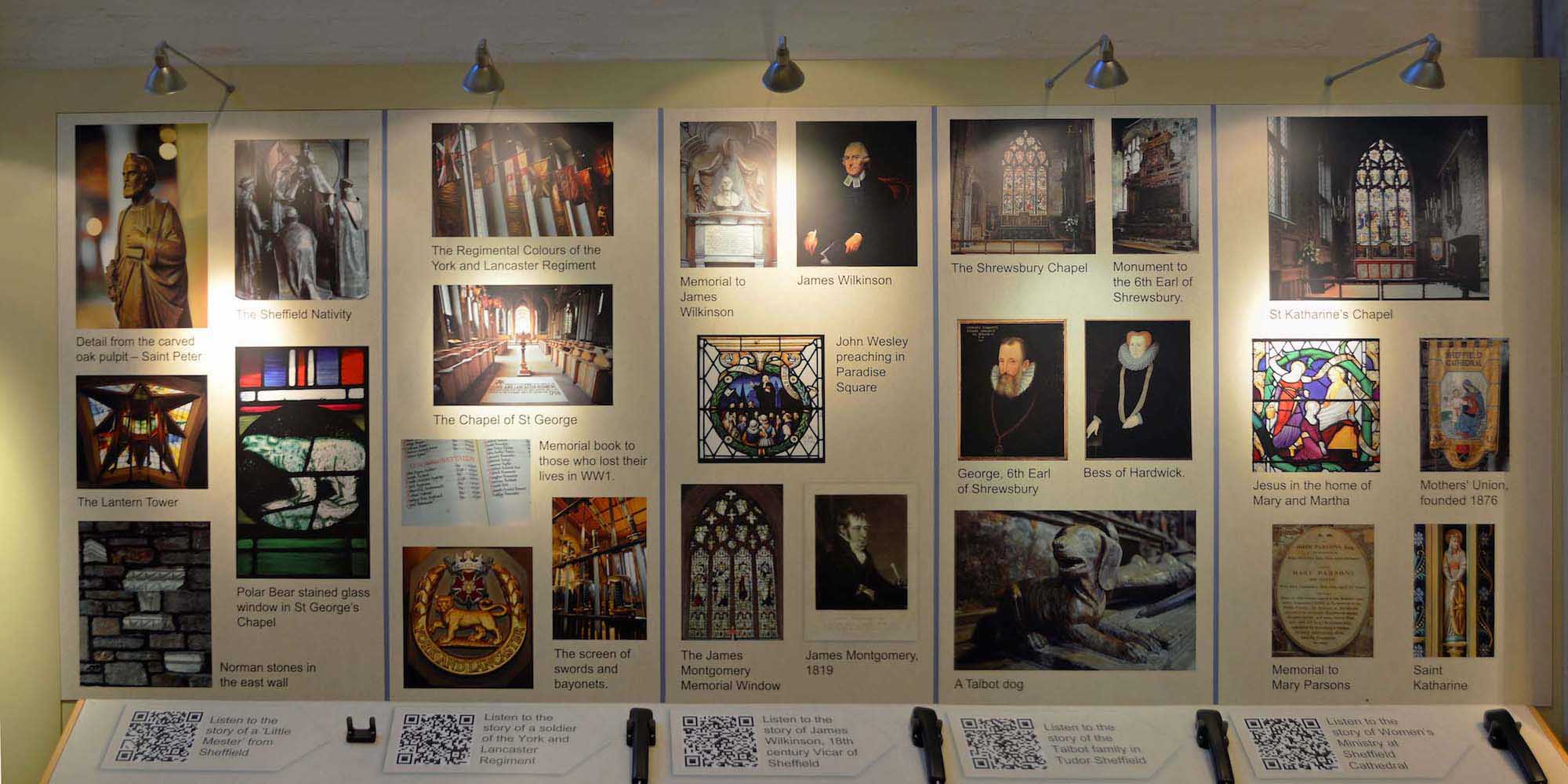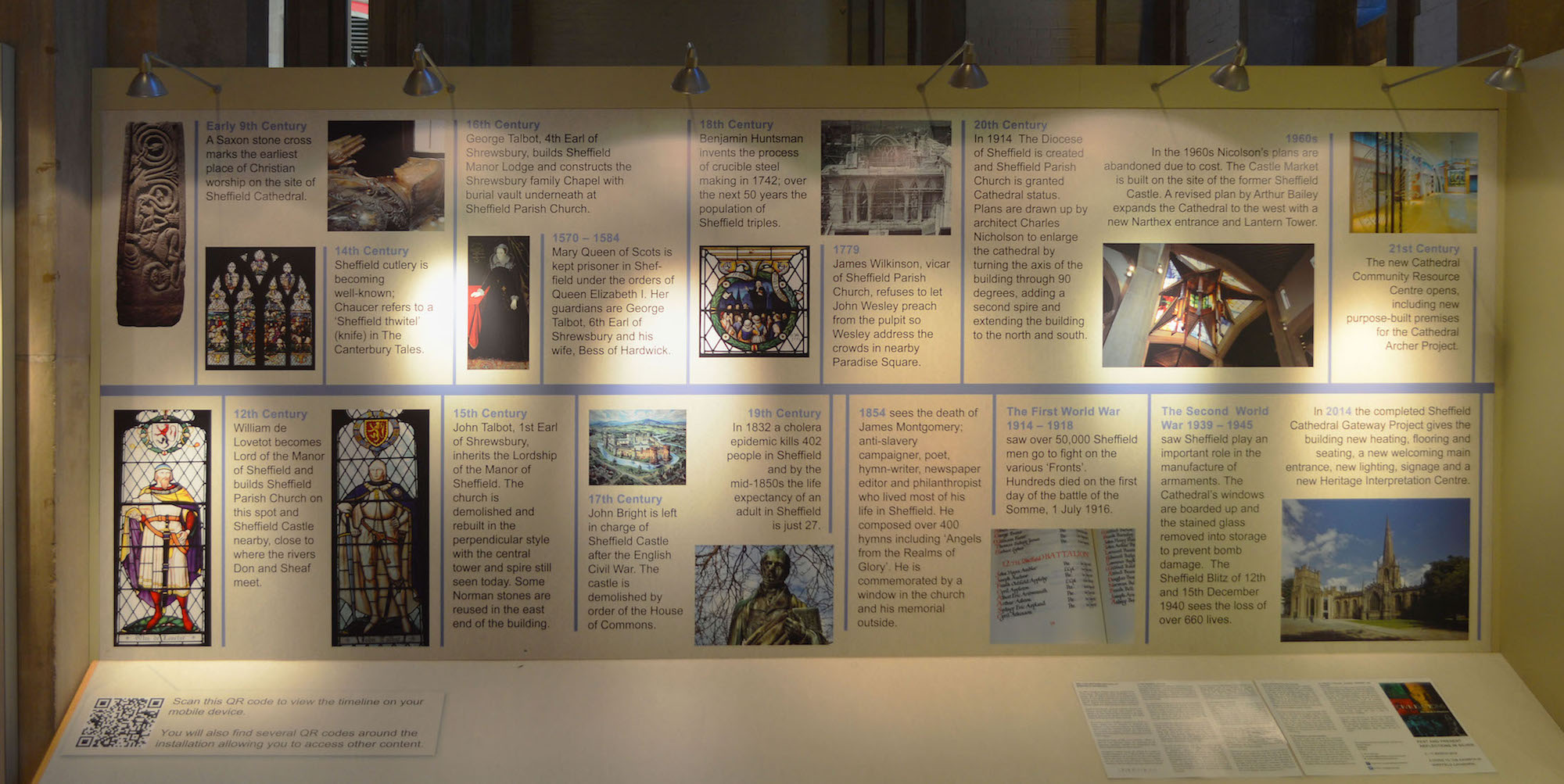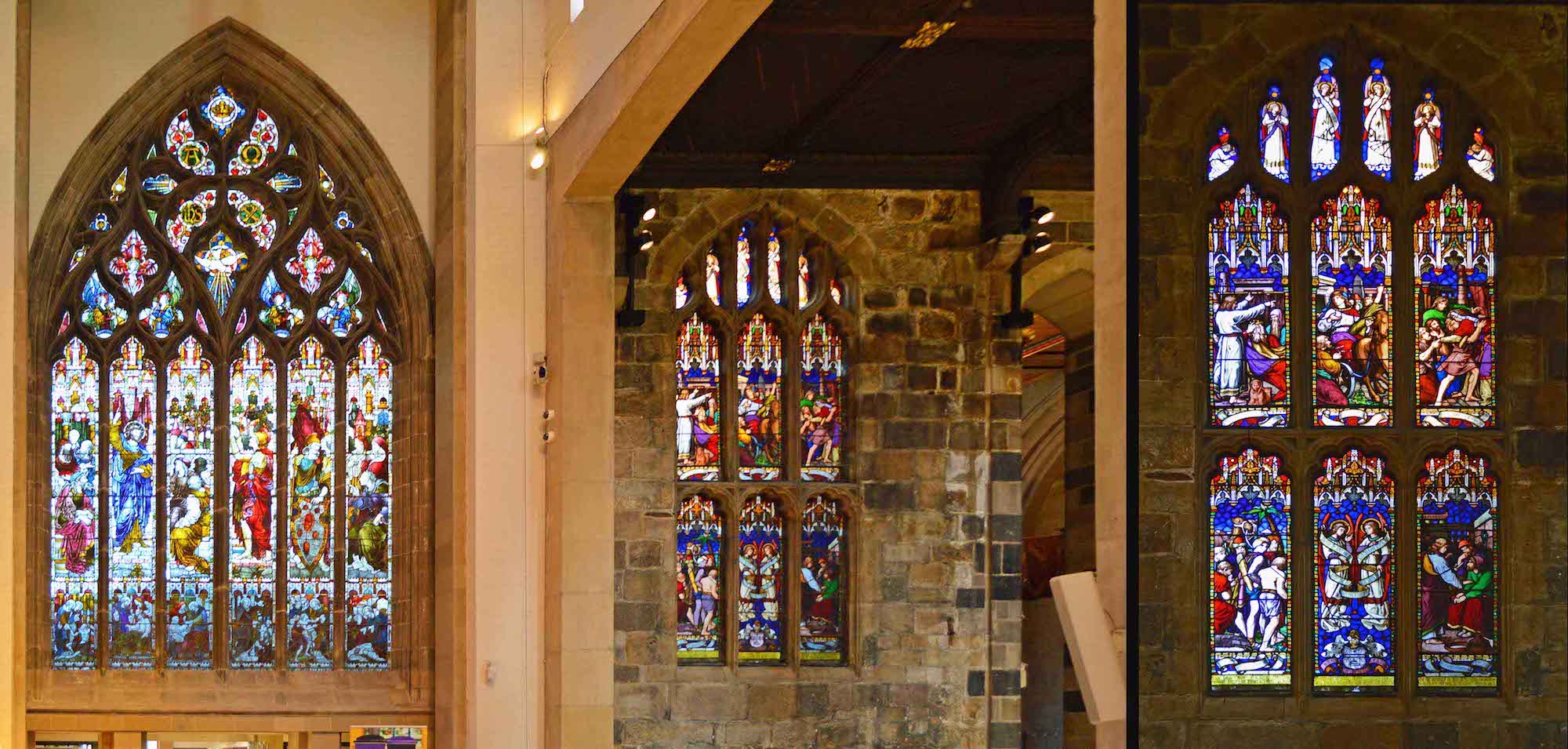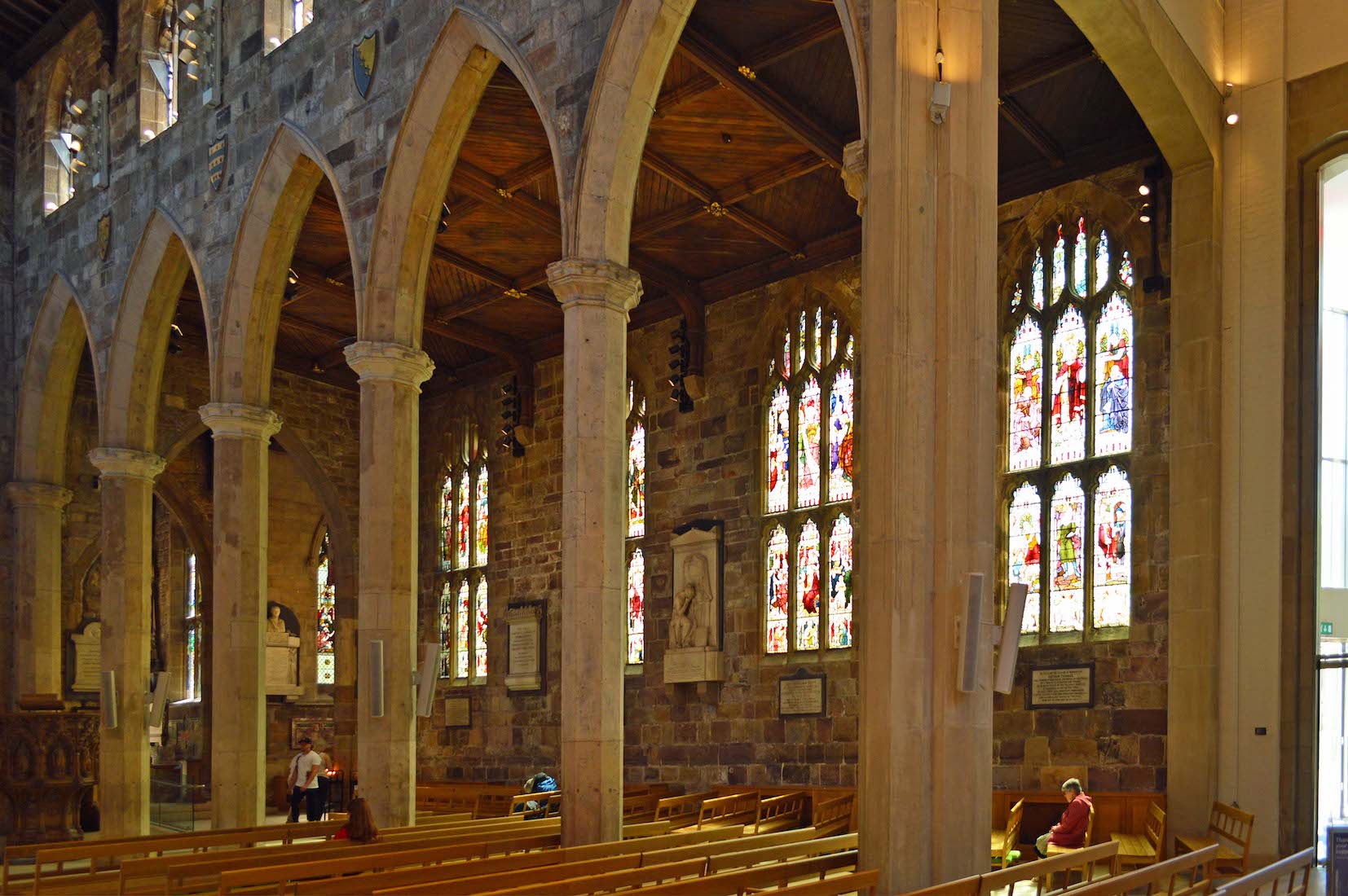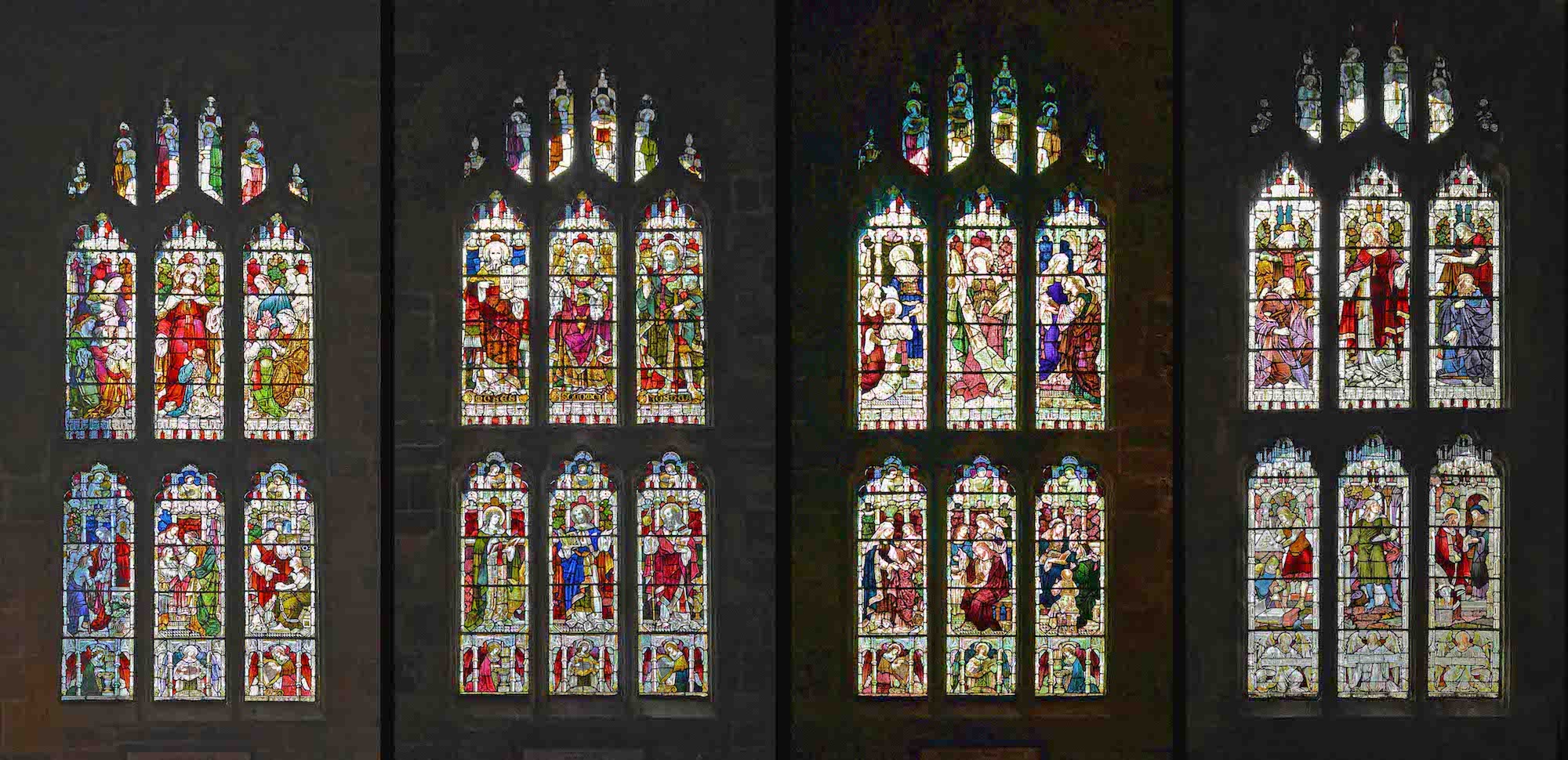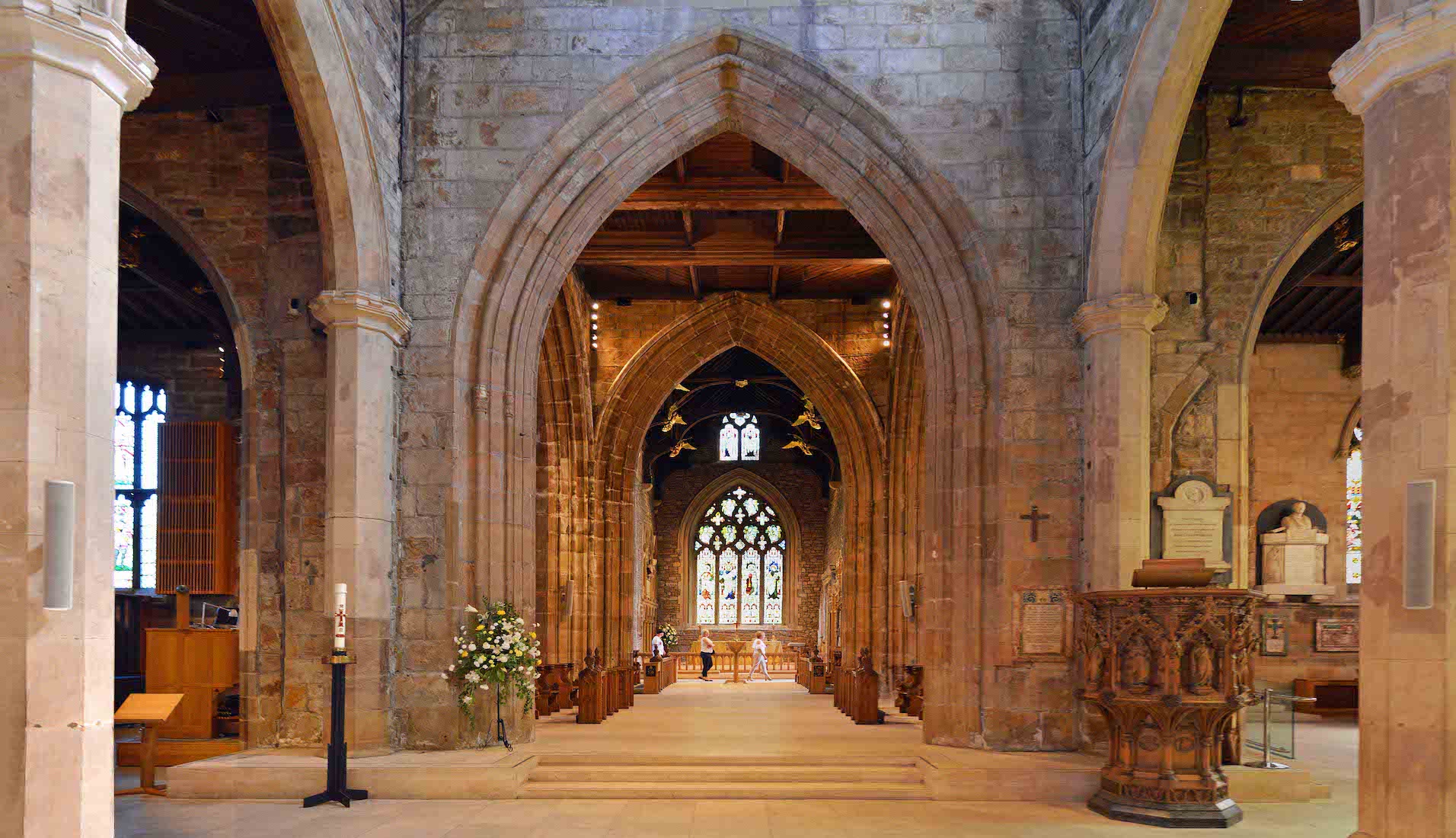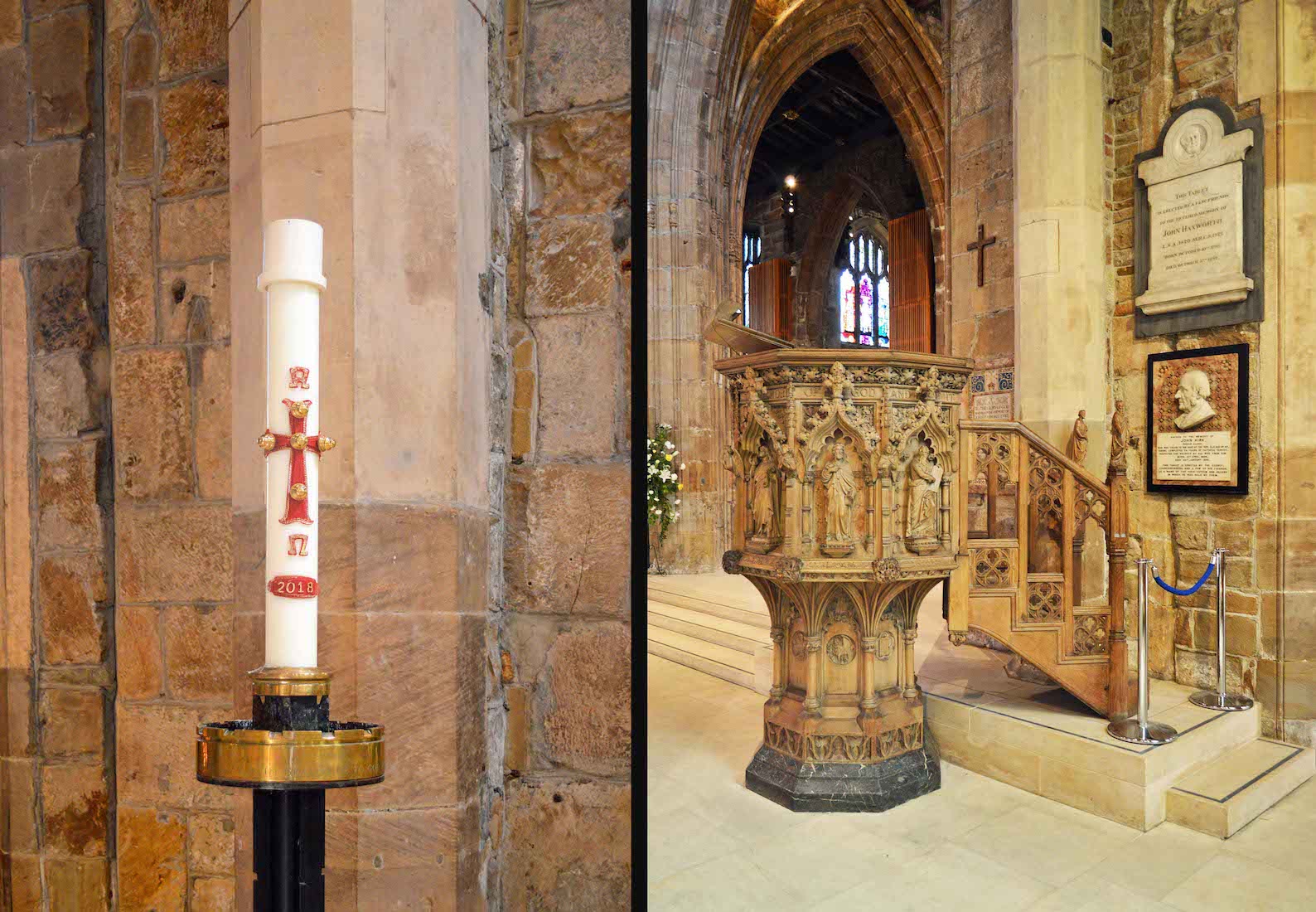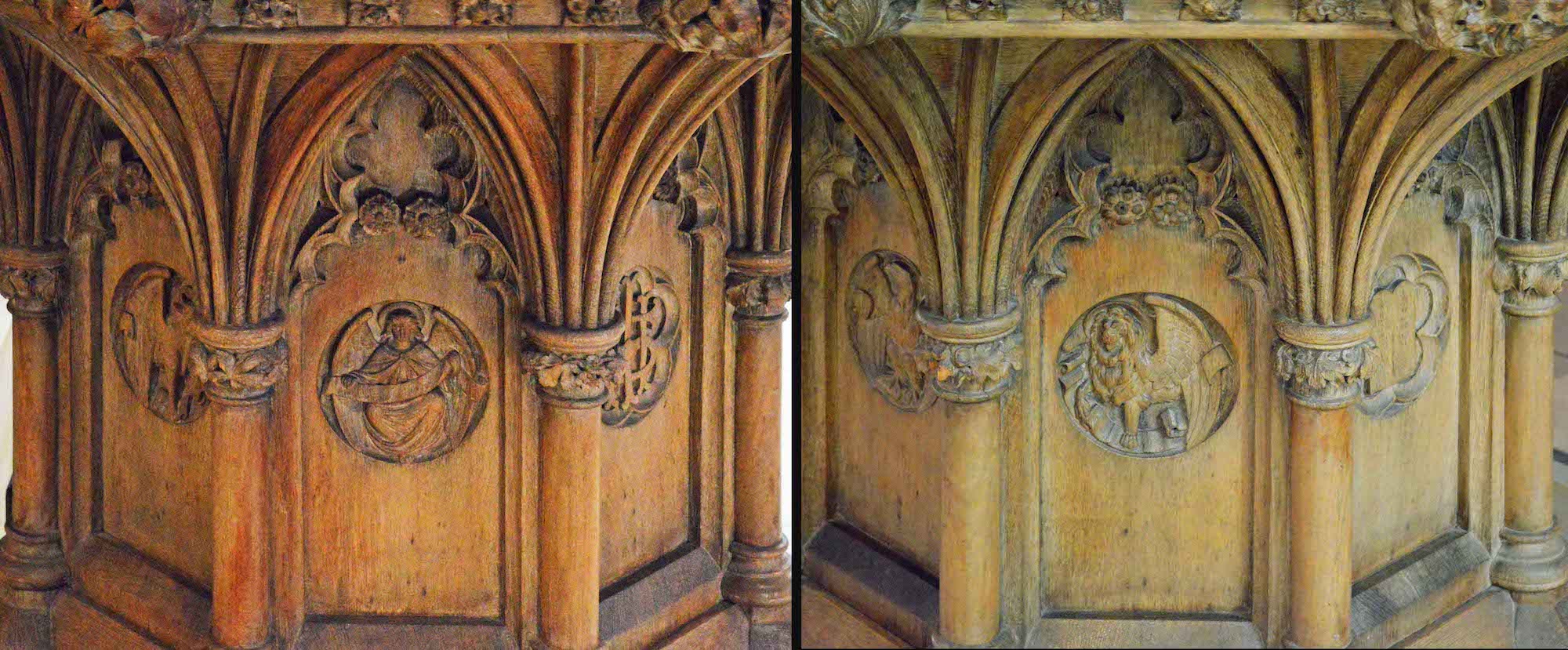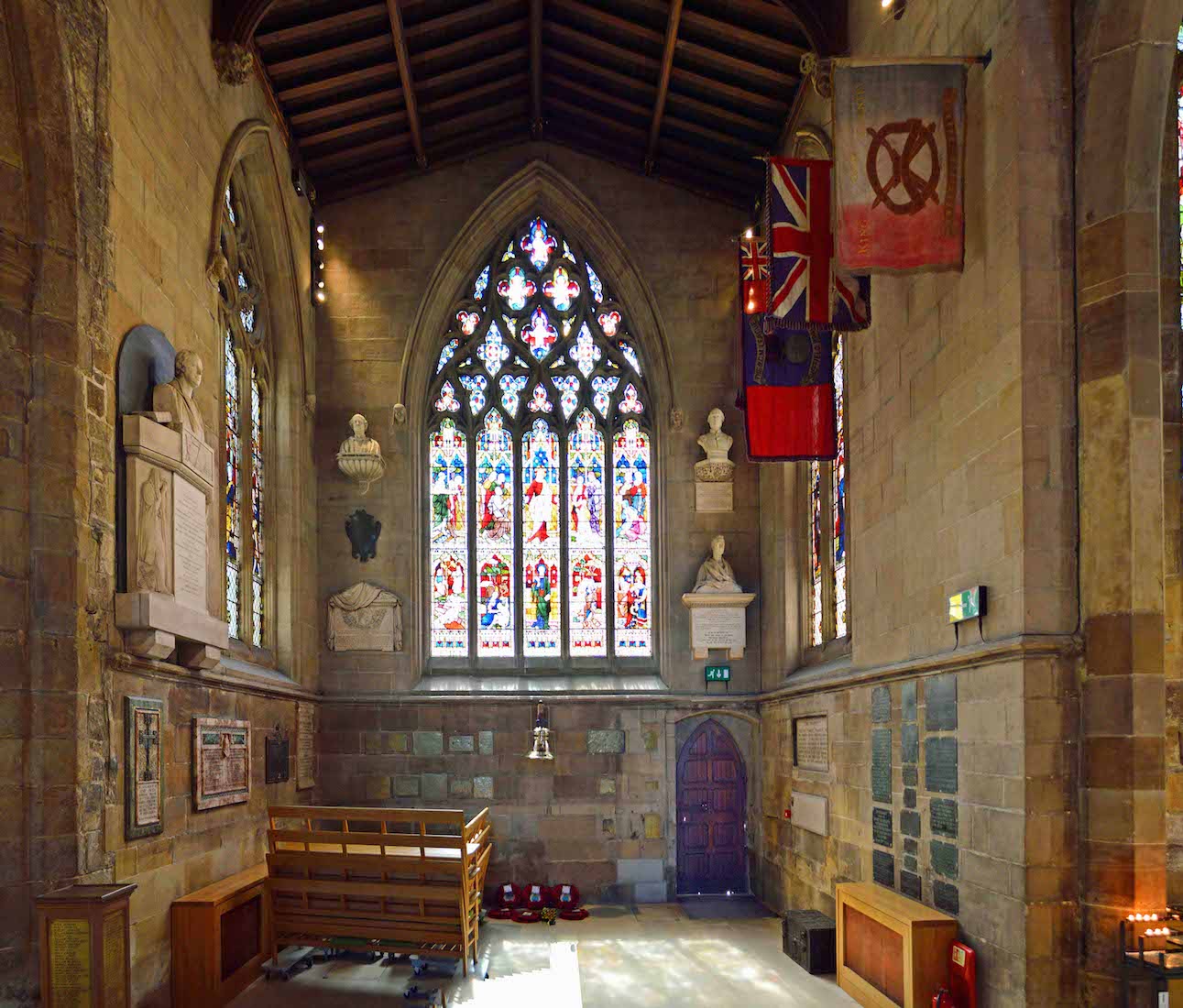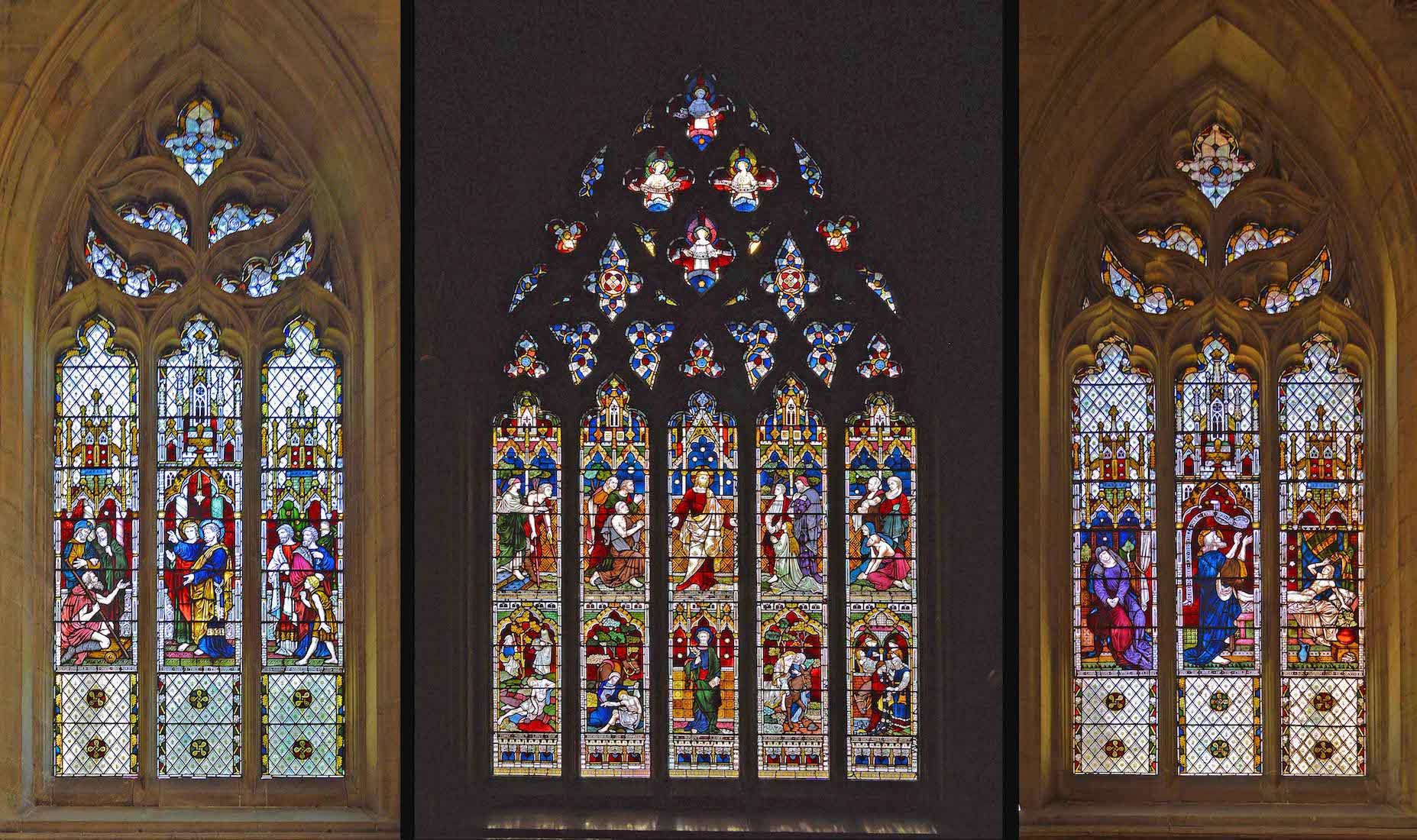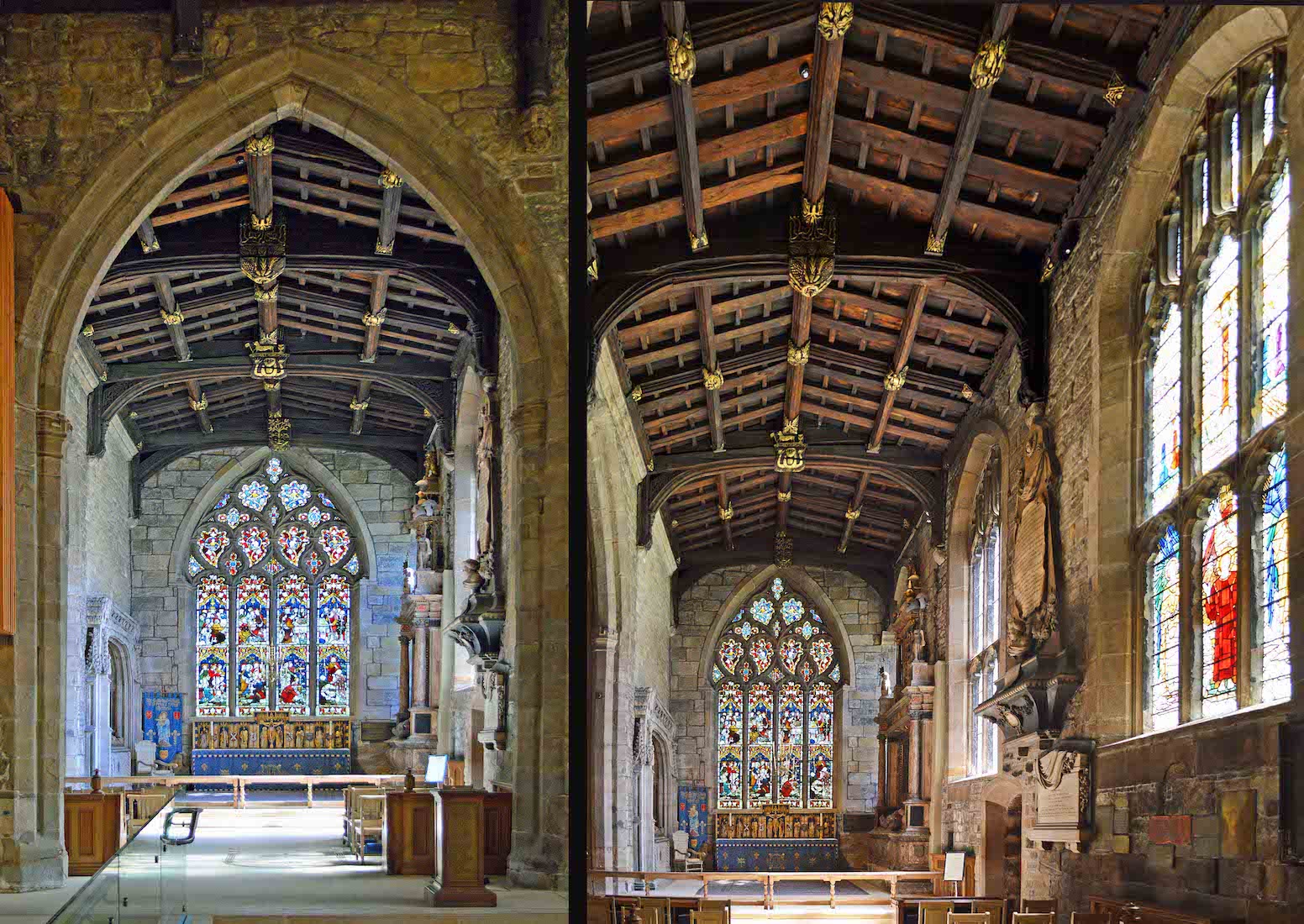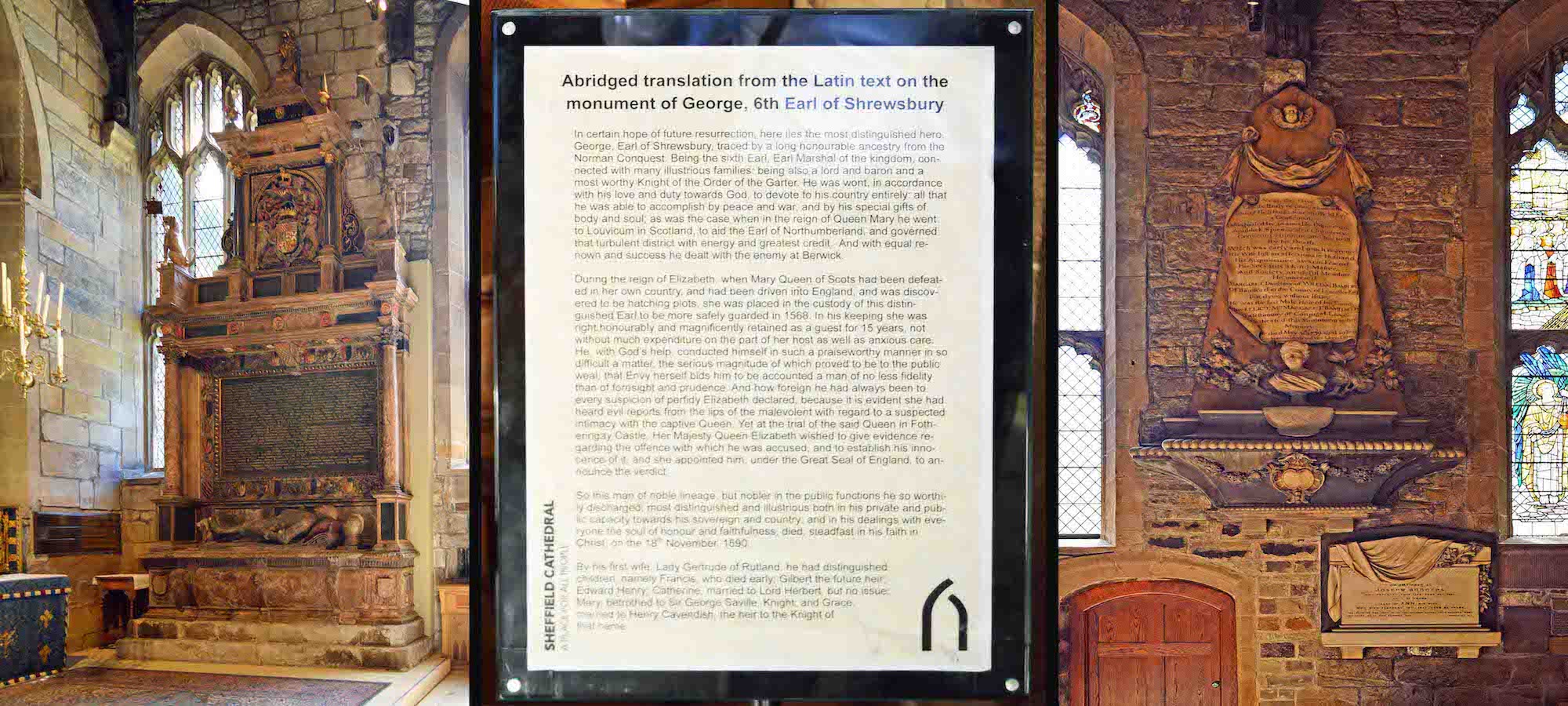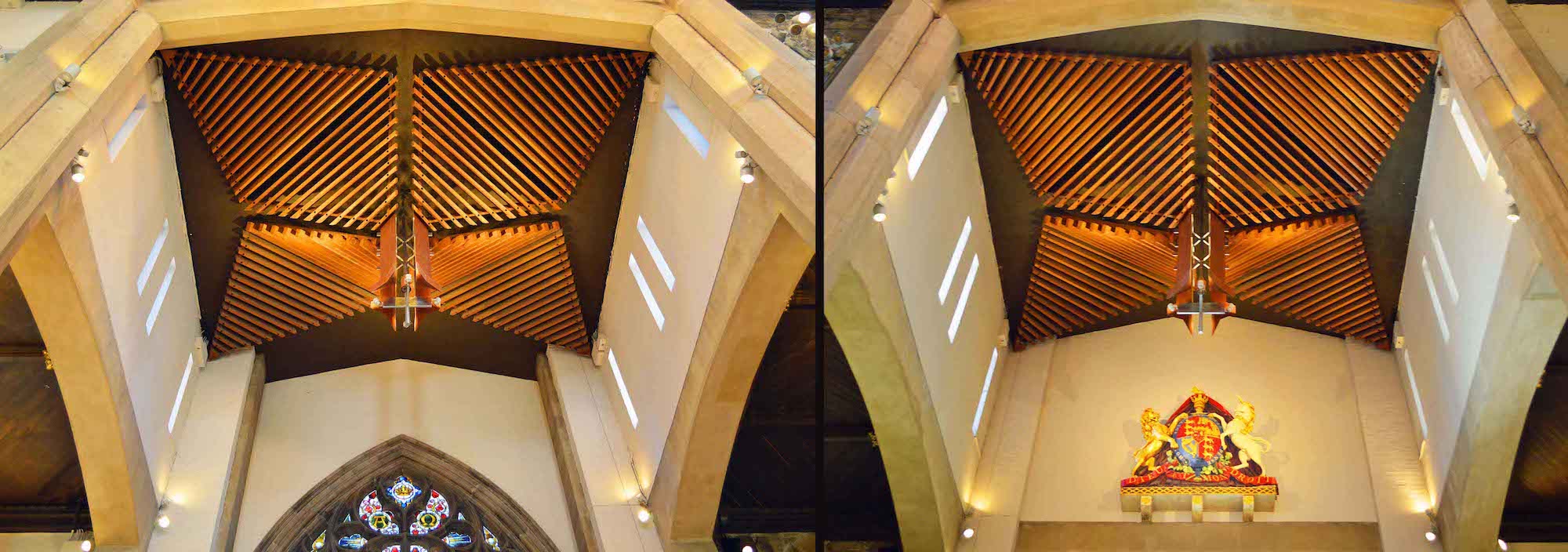
On either side of the lantern there is a delightful square roof decoration – a star designed with timber. The second view also shows the Royal coat of arms, with the motto ‘God and my right’. PLAN
22. HERITAGE INTERPRETATION CENTRE

The Heritage Interpretation Centre has various visual and audio-visual displays relating to the Cathedral. In the centre is an interesting model of the Cathedral showing the centuries during which the different parts were added..
23. HERITAGE NORTH DISPLAY
The photos on this wall show large and small items from all around the Cathedral – including carvings and stained glass scenes, as well as pictures of people associated with the Cathedral. The earphones are for listening to historical stories relating to the Cathedral.
24. HERITAGE SOUTH DISPLAY
On this wall there is a pictorial outline of the hstory of the Cathedral, showing key dates and the events of that time. I like the 9th century Saxon cross!
25. NORTH NAVE WINDOWS
Because of various additions to the North nave, there are only two windows on this side. One is the window above the cafeteria doors which we have already seen. The adjacent smaller window appears to show scenes from the life of Joseph: there are strong allusions to Egypt!
26. SOUTH NAVE
The South nave has a full wall of windows from the South transept to the entry. There are four stained glass windows here, and we look at them more closely ... . There is some difficulty here as the windows have little intrinsic annotation and do not seem to be well documented.
27. SOUTH NAVE WINDOWS
Here are some ideas on the windows, from left to right. • Mothers bringing their children to Jesus, and below, healing miracles of Jesus. • At top, Old Testament characters Moses, Solomon and Joshua – all labelled. • Six separate scenes including at top Hannah presenting Samual, and St Cecelia? Below, Mary of Bethany anoints the head of Jesus, and Anne teaches her daughter Mary(?). • Various parables of Jesus.
29. PASCHAL CANDLE AND PULPIT
The Paschal candle is a symbol that Jesus is the Light of the World. It has special significance over the Easter period. The carved Victorian pulpit was the gift of George Wilson, chairman of the famous Cyclops Works in Sheffield who died in 1885. We notice a couple of memorial tablets to the right, and at the bottom of the steps the figures of Saints Peter and Paul.
30. PULPIT DETAILS
The pulpit is decorated with angels and the carved figures of Christ the Good Shepherd, Matthew, Mark, Luke, John and Moses with the Ten Commandments.
31. PULPIT BASE
The pulpit base is also carved with various interesting Christian motifs. Again these are quite difficult to decipher, but it looks like the emblems of the Four Evangelists alongside the Laws of Moses and the IHS monogram for Christ.
32. SOUTH NAVE ICON
We now follow up the South nave aisle past the South transept and to the Shrewsbury Chapel. On the way we pass this icon representing Sheffield Cathedral. The Saints Peter and Paul stand on the sides, jointly holding a simple model church. Perhaps the Cathedral did look like this in its very early days ... !
33. SHREWSBURY CHAPEL AND PARKER SOUTH TRANSEPT
A little further along, we see how the South transept branches off to the right, with the Shrewsbury Chapel ahead. This transept called the ‘Parker Transept’ with the stained glass windows and all pertaining to it, was erected at the sole cost of Ann Parker, of Broomgrove Cottage, in loving memory of her husband, Samuel Parker FRCS, late Honorary Surgeon to the Sheffield General Infirmary who died in 1876.
34. SOUTH TRANSEPT
There is a great deal of detail in this transept. As well as the three windows, we notice the flags (colours) hanging above at right, the many memorial tablets and plaques, and the Sheffield Bell.
35. SOUTH TRANSEPT WINDOWS
The windows depict, from left : • Peter and John healing the crippled beggar by the Temple gate (Acts 3). • Above, Jesus exercising his ministry of healing and raising the dead, and below, St Luke and scenes from the parable of the Good Samaritan. • Elijah raising the son of the widow of Zarephath from death.
36. SOUTH TRANSEPT MEMORIALS
There are very many memorials in this transept. Here we have at left, a memorial to the members of the Sheffield Police Force and Fire Brigade who gave their lives in the Great War 1914–1919. The plaque at right gives information about the naming and history of the Parker Transept.
37. SHEFFIELD BELL, TRANSEPT ROOF
The transept is quite short. It has a simple gable roof with gold bosses. • HMS Sheffield was a cruiser of the Royal Navy during the WWII. She took part in actions against several major German warships. Unlike most Royal Navy ships of her time, her fittings were constructed from stainless steel instead of brass. The stainless steel ship’s bell, which was made by Hadfield’s of Sheffield, was preserved and today hangs in the Cathedral along with her battle ensign.
38. SHREWSBURY CHAPEL
We leave the transept and proceed to the Shrewsbury Chapel. This chapel was added to the Parish Church around 1520 by the Lord of the Manor of Sheffield, George Talbot, the 4th Earl of Shrewsbury. It was built to be a private family chapel with a burial vault underneath. It is an impressive chapel with stained glass windows, some large memorials, and a delightful reredos and altar.
39. SHREWSBURY CHAPEL MEMORIALS
The large memorial at right in this chapel is for Sir George Talbot, 6th Earl of Shrewsbury, 6th Earl of Waterford, 12th Baron Talbot, KG, Earl Marshal (1528 – 1590). He was an English magnate and military commander. He also held the subsidiary titles of 15th Baron Strange of Blackmere and 11th Baron Furnivall. The smaller memorial at right remembers George Bamford (1710 – 1739).
40. SHREWSBURY CHAPEL ALTAR AND WINDOWS
The altar in the Shrewsbury Chapel is a rare pre-Reformation stone ‘Mensa’ marked with carved consecration crosses. The reredos (screen) behind dates from the restoration of the chapel in 1935 and features Christ and the saints whose chapels were part of the medieval church. I can find no references to the windows.


